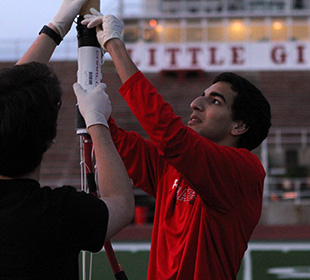Imagine a video of Wally Wabash floating in space with the curvature of the Earth visible just over his shoulder.
Cool, you say.
So did Kalp Juthani ’15, so he assembled a team, constructed a craft, and sent it to the upper atmosphere – upwards of 87,000 feet.
Juthani and fellow members of Little Giant Productions launched a helium-filled weather balloon loaded with a Wally bobblehead doll and a video camera on March 21 from Hollett Little Giant Stadium.
The six-pound craft contained a parachute for its descent, fruit flies, a data logger to record altitude, temperature, and pressure, and tracking units including a GPS locator and an amateur radio to aid in recovery.
It’s one thing to send up a camera. It’s another all together to send up Wally. That makes this attempt unique.
“I had noticed that other college campuses were launching weather balloons and capturing the flight,” said Juthani, “but never with their college mascot. Our goal was simply to get Wally into near space and to see what it looks like when he gets up there. Just seeing that would be mystifying.”
 And a mystery it remains. While the launch itself was very successful, the craft separated during descent. One half landed in Connersville and was recovered. The other half, securing the camera, landed in a pond in Greenfield. The camera detached and has yet to surface.
And a mystery it remains. While the launch itself was very successful, the craft separated during descent. One half landed in Connersville and was recovered. The other half, securing the camera, landed in a pond in Greenfield. The camera detached and has yet to surface.
It’s probable that Wally may have led to that separation.
“The greatest challenge in putting together this project was securing Wally to the craft, and securing him in a way that we could film him,” explained Juthani. “The techniques used to film at high altitude usually don’t involve something as heavy as a bobblehead. Generally, these crafts are not as bulky or oddly shaped. That may have caused the craft to split in two upon the descent.”
While still working to recover the submerged camera, the missing footage leaves the experiment without a conclusion. The scientist in him understands the setback; the filmmaker wants to complete the story.
“Not only would the video allow us to show and tell the story of what we were able to accomplish, but it will also allow us to overlay our data to provide us with a better idea of what actually happened once the balloon popped,” he explained.
The idea behind the launch had marinated within Juthani since high school. It took a while for him to pull together the elements that would allow him to merge two of his passions: science and film.
“I’m a video guy and a science guy,” said the biology major from Fishers, IN. “Some of the skills I’ve learned in chemistry and physics – force and lift equations, as well as, gas constants – have helped here to build a mechanism that made it up there. My work with fruit flies inspired me to see if we could build a capsule in which our crew could survive the inhospitable nature of space and impact – three flies made it back alive.”
The amount of work to this point was nearly daunting. Juthani smartly enlisted the help of fellow students and professors across campus. From chemistry and physics to the student senate and the media center, many, have contributed to this point.
Wally’s bracket was designed and built with the help of chemistry professor Lon Porter and the department’s 3D printer.
“When he first pitched the idea to me, I thought it was pretty insane,” said Porter. “It seemed way too difficult to make it happen unless you have both the equipment and the necessary army of engineers, programmers, and artists. The fact that Kalp took it upon himself to make this happen by tapping into the diverse talent on campus was ingenious.”
An unsuccessful launch attempt in the fall brought on a complete evaluation of the effort. Juthani and crew enlisted the help of Dr. Howard Brooks of the Balloon Assisted Stratospheric Experiments program at DePauw University. The contributions of many, the testing, planning, even the camaraderie have him confident in the results.
“Even just a few weeks ago, I never could have imagined launching Wally into space,” Juthani said. “We put in a lot of hard work as a team in developing and redeveloping it and making sure all of the details were addressed. If this project has taught me anything, it’s that hard work and persistence pay off.”
Porter sees another positive from this. He’s proud of Juthani for engaging others to learn in a hands-on way outside of your comfort zone.
“Significant problems in the modern world require collaboration and teams of experts in diverse areas,” Porter said. “Anything worth doing requires a significant effort and those who give up easily will rarely make significant contributions. Failure is a gift at times in that it forces us to reevaluate an approach, rethink assumptions, and to engage creativity in problem solving.”
Juthani sees that initial failure as a gift.
“Failing the first time allowed us to re-evaluate the challenge at hand and gave us new insight,” he said. “It gave us the opportunity to work with Dr. Brooks and had we not worked with him, this project may not have been successful.”
He’ll continue to search for ways to recover the camera and cap the project. “The visual is the missing piece,” Juthani concluded.